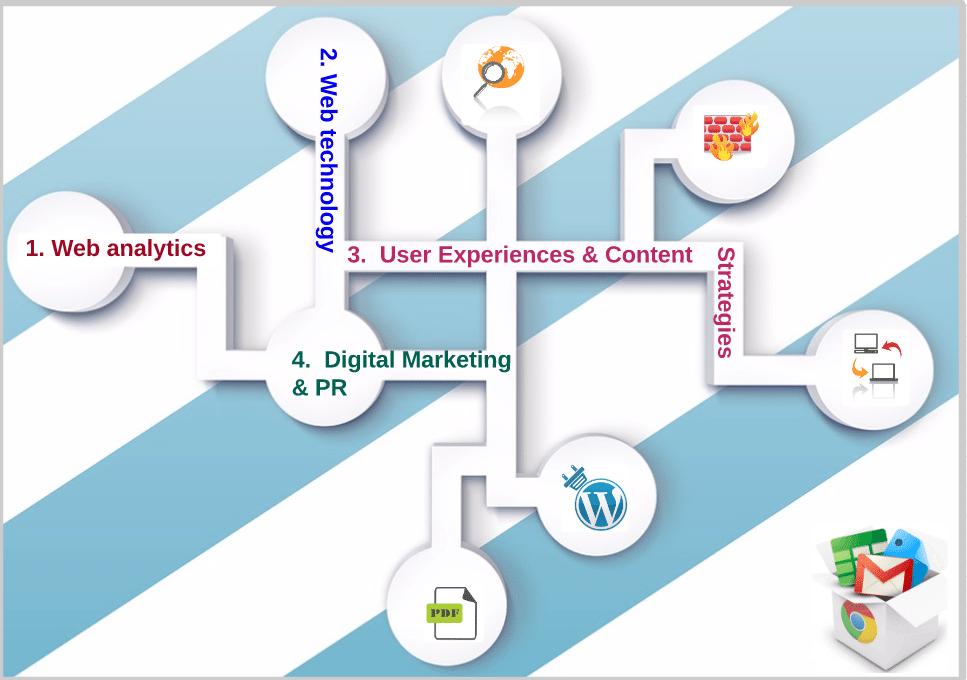The term web presence usually takes people by surprise when a discussion starts up about creating content for their school website and other web properties. For that reason, a technology glossary such as whatis.techtarget.com is more than handy link to clarify the term!
In the case of ‘web presence’, the glossary makes clear that the entities such as a website. social media pages, digital images and curated texts live on ‘servers’ that are not tied to a specific geographic location, but are “somewhere in cyberspace.” The implication for school leaders is that the monitoring and management of those technical properties are fundamental to their use of the digital technologies hosted and stored on those servers.
The other striking issue is that when working with new technologies, looking up one term has you need to look several as the realisation hits you that you really are entering a new and unfamiliar territory.
Not just a website
Our decision to focus on school’s web presence, rather than its school website, came about in that way.
We know that understanding how to produce content for the web is complex. A school is in danger of missing the most important point about what the content must be, that is, relational, connected and contextualised within a network. Some of that content schools control and some they do not. After all, that is what it means to be on an internet!!
On the other hand, working through the concept of a ‘web presence’ means that schools consider issues of context in relation to technological change and its implementation. This makes them less likely to think that they must create so-called ‘brochure-like’ website.


What does 'web presence' consist of?
We believe that a school’s ‘web presence’ can generally be understood through four factors:
- The Basics – Design, User Experience & SEO: The technical analysis of your site is essential to provide you with an effective platform on which to base your communications. We perform an analysis to view how your site is optimised for search engines and provides a reliable user experience. Our report will make recommendations to improve your existing site architecture. We’ll outline how you can create a better first impression through a more consistent approach to your content then provide you with a plan for creating and maintaining new content that will engage and inform all segments of your audience throughout the academic year. We look at links your school has on other sites such as ‘My School’ and possibly ‘good school guide’ sites.
- Collaboration and online interactions: Our specialist knowledge of educational content writing and production ensures that you get an examination of how different channels of communication on the web are working with building relationships with parents. We examine the case for your current community and the attractiveness of your web presence for prospective parents. We look at the ownership of content and the relational nature of outcomes specified in your ICT policy and strategic plan.
- Representations of teaching and learning: With a depth of knowledge of innovative ways of teaching, its relationship to digital learning, as well as an eye on the latest research with regards to brain theory, we work to see if you have taken the wide scope of opportunities open to you through digital technologies in showcasing your school ethos and culture. It is our experience that school leaders under-report the exemplary work that is occurring in classrooms. This is no one’s ‘fault’ and largely due to the busyness of school life. We particularly believe in growing the kudos of school leaders and their staff in the challenge of meeting the needs of every child.
- Integrating ‘acceptable use’ criteria: Cybersafety and risk management are crucial to an effective management of a school’s web presence. We examine how security is integrated alongside productive forms of risk-taking within a culture of resilience and responsibility. We look, for instance, at your school’s use of BYOD and 1-on-1. We look to see how the agreement that staff and students make around ‘acceptable use’ is envisioned as part of living as digital citizens.
Sign-up to our newsletter?
There have many attempts to draw up the perfect infographic of web presence in digital marketing circles. You only have to search Google Images with the keywords “web presence” to verify this fact. There will be hundreds more as educational content, rather than that created for commercial purposes, arises around the subject.
Given its relational nature, our approach is about growing a school leader’s understanding of web presence in two steps in our newsletters:
- by initially tackling the technical vocabulary itself by guiding the evolving meanings of the terms currently in use;
- by applying the terms to use cases from which the school leaders can find comparable situations to their own school contexts.
The ‘use case’ technique is taken from Agile project management, the method used by software development companies . You don’t need to become a fully fledged practitioner of the Agile methodology to apply use cases to your leadership work. Rather, you can exemplify to your staff that ‘the answer’ to complex issues in your schools are likely to come from bringing together knowledge from a number of fields.



